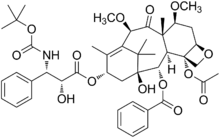Cabazitaxel
 | |
| Clinical data | |
|---|---|
| Trade names | Jevtana |
| AHFS/Drugs.com | Consumer Drug Information |
| MedlinePlus | a611009 |
| License data |
|
| Pregnancy category |
|
| Routes of administration | Intravenous |
| ATC code | L01CD04 (WHO) |
| Legal status | |
| Legal status | |
| Identifiers | |
| |
| CAS Number |
183133-96-2 |
| PubChem (CID) | 9854073 |
| IUPHAR/BPS | 6798 |
| DrugBank |
DB06772 |
| ChemSpider |
8029779 |
| UNII |
51F690397J |
| ChEBI |
CHEBI:63584 |
| ChEMBL |
CHEMBL1201748 |
| ECHA InfoCard | 100.205.741 |
| Chemical and physical data | |
| Formula | C45H57NO14 |
| Molar mass | 835.93 g/mol |
| 3D model (Jmol) | Interactive image |
| |
| |
| | |
Cabazitaxel (previously XRP-6258, trade name Jevtana) is a semi-synthetic derivative of a natural taxoid.[1] It was developed by Sanofi-Aventis and was approved by the U.S. FDA for the treatment of hormone-refractory prostate cancer on June 17, 2010. It is a microtubule inhibitor, and the fourth taxane to be approved as a cancer therapy.[2]
Cabazitaxel in combination with prednisone is a treatment option for hormone-refractory prostate cancer following docetaxel-based treatment.
Clinical trials
In a phase III trial with 755 men for the treatment of castration-resistant prostate cancer, median survival was 15.1 months for patients receiving cabazitaxel versus 12.7 months for patients receiving mitoxantrone. Cabazitaxel was associated with more grade 3–4 neutropenia (81.7%) than mitoxantrone (58%).[3]
See also
References
- ↑ http://www.cancer.gov/drugdictionary/?CdrID=534131
- ↑ "Jevtana (cabazitaxel) Injection Approved by U.S. FDA After Priority Review" (Press release). sanofi-aventis. 2010-06-17. Retrieved June 17, 2010.
- ↑ "Cabazitaxel Effective for Hormone Refractory Prostate Cancer After Failure of Taxotere".
External links
- Cabazitaxel - Official web site of manufacturer.
- Cabazitaxel Prescribing Information - Official prescribing information.
- U.S. National Library of Medicine: Drug Information Portal - Cabazitaxel